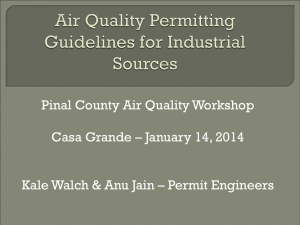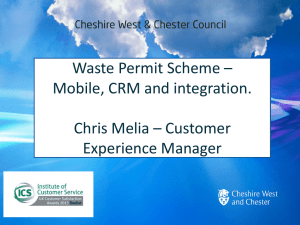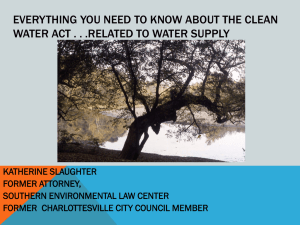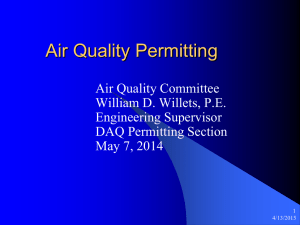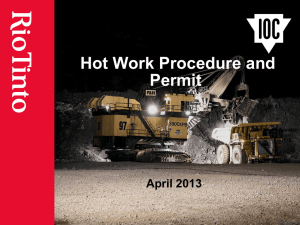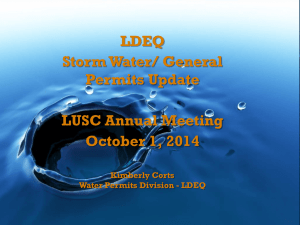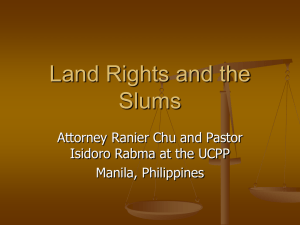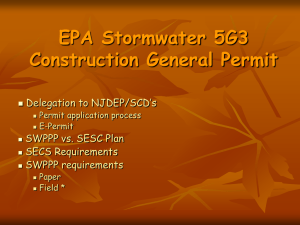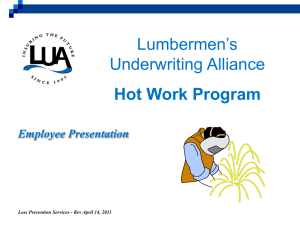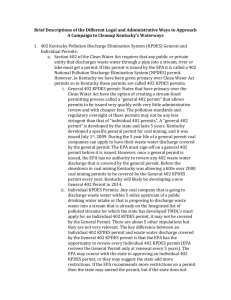Title 5 Training (2)x
advertisement
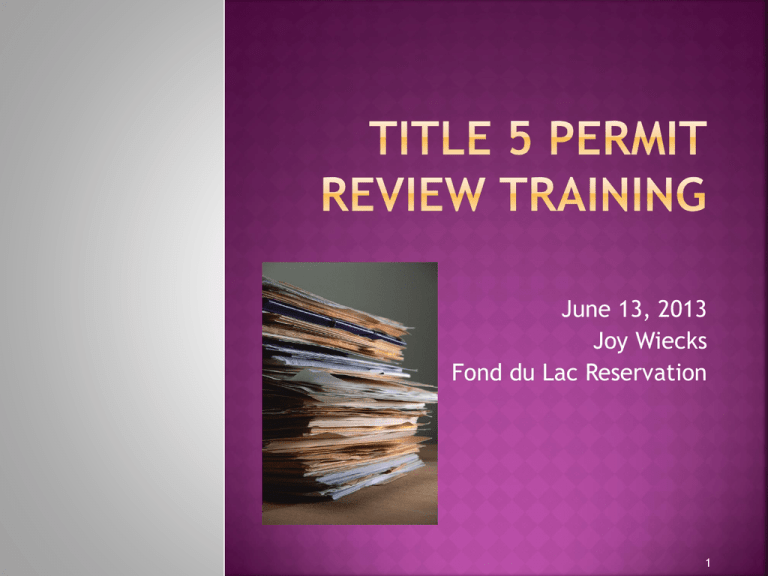
June 13, 2013 Joy Wiecks Fond du Lac Reservation 1 Description Features Sources they cover Reviewing them 2 Air quality goals were not met Confusion as to what requirements applied to a facility Existing rules often lacked monitoring Limited public access and comment Weak compliance oversight Purpose of Title V permit: accountability, improved compliance and enforcement for facilities that have started operating 3 Refers to Title 5 of the CAA Operating permits, not construction “Bucket” program Contains enforceable conditions (federal or state) Addresses major sources (see next slide) Grows with the facility Updated regularly Addresses criteria pollutants, toxics, and greenhouse gases 4 Any major source Any facility with Potential To Emit above: 10 tpy any one toxic; 25 tpy of combination of toxics; 100 tpy any regulated pollutant; lesser amounts if in n/a area. Any solid waste incineration unit under CAA section 129 See www.epa.gov/oaqps001/permits/obtain.html for updated list of non-major sources; most non-majors are exempt from Title 5. Many facilities took limits to avoid Title 5 (Synthetic Minors) 5 Covered under Federally Enforceable State Operating Permit (FESOP), minor NSR permits, or state prohibitory rules Different from a true minor Needs federally enforceable limits to stay under major source threshold Sources may choose to be synthetic minor for different reasons 6 Requires compliance certification from a high-level company official Adds enhanced monitoring (sometimes), record-keeping, and reporting requirements and schedules for these Has citizen suit opportunities Forces a facility-wide look, potential reductions “Insignificant units” can be left out of the permit application (but not the permit) 7 Permit Term PSD Permit Title V Permit Emission limits 2.3 lbs/hr of NOX 1.7 lbs/hr of CO .5 lbs/hr of VOC 2.3 lbs/hr of NOX 1.7 lbs/hr of CO .5 lbs/hr of VOC Monitoring and testing Perform initial compliance Measure NOX and CO at least once per quarter, test within 30 days of engine using a portable analyzer and monitoring protocols retrofit approved by EPA For VOC, conduct a performance test once every 5 years using protocol approved by EPA Recordkeeping Record initial test results Keep records of: Date, place and time of sampling or measurements Date(s) analyses were performed Company or entity that performed the analyses Analytical techniques or methods used Results of such analyses Operating conditions as existing at the time of the sampling Retain records of all required monitoring data and support information for at least 5 years 8 Periodic Title 5 updates incorporate new requirements SIP limits that result from updated NAAQS New requirements such as Maximum Available Control Technology, New Source Performance Standards, National Emissions Standards for Hazardous Air Pollutants Regional haze requirements (Best Available Retrofit Technology) Updates to otherwise ensure compliance 9 Applies to major sources of toxic pollutants (PTE of 10 tpy of single HAP, or 25 tpy of multiple HAP’s) EPA sets MACT emission levels offers choices of control options MACT based on the top-performing 12% of industry sources EPA required to do an 8 year residual risk review Source can take limits to stay out of MACT if done before specific regulation passed 10 Basics (same for most permits), “thou shalt’s/shalt not’s” For each process line or emissions source, the permit generally has: Description of process and its stacks and pollution control equipment Emission limit or other type of limit Monitoring, recordkeeping and reporting 11 What to do Why to do it Line 3 may emit no more than 0.3 lbs of NOx/hr Requirement xxx.111 Lines 1, 2, and 3 may emit no more than 52 lbs of NOx/hr Requirement yyy.222 Lines 1, 2, and 3 may emit no more than 245 tons of NOx/yr Requirement zzz.333 Line 3 may burn only solid fuel Requirement xxx.111 Lines 1 and 2 can burn solid and liquid fuel Requirement sss.555 12 Permit limits/requirement come from: Federal programs (i.e. NSPS, BART, MACT) NSR permits State-only requirements SIP requirements Enforcement actions If reason not clear, check with permit engineer Facility needs to demonstrate how they’re meeting limits 13 Requirements needed to meet NAAQS and state standards Requirements needed to meet Class II increment (measure of how much additional pollution is allowed) Requirements needed to meet Class I increment, visibility, and acid deposition, air toxics programs Appropriate emission controls Any required mitigation 14 For any permit standard or limit, there must be monitoring, reporting, and recordkeeping Frequency of monitoring depends on: how close to NAAQS emissions are; health effects of pollutant; cumulative emissions; variability of emissions Semi-annual monitoring reports, plus compliance certification Records kept on-site for 5 years 15 Operational Restriction or Emission Limitation Monitoring Recordkeeping Reporting Testing Stack test Keep on file for 5 years 60 days after final report Test method CEM’s Keep on file for 5 years Report deviations Certify CEM’s every year 0.3 lbx NOx/hr on Line 3 Opacity 16 Need to make sure equipment is functioning properly Do this thru stack testing or parametric testing Parameters: scrubber water flow rate, ESP voltage, fabric filter pressure drop Need ranges, and actions to take if parameters outside range One pollutant can serve as a surrogate for another 17 Units subject to pre–1990 rules Units subject to a SIP requirement for which there is no reasonable compliance assurance method specified Units subject to old NSR permits Voluntary terms created in the Title V permit 18 Facilities have operating and maintenance plans for equipment Inspection frequency, employee training, spare parts kept on-site, etc. Dust control plans Monitoring equipment operation plans All of the above can be incorporated by reference 19 Many items require judgment calls on the part of the permit engineer. Frequency of testing Stack testing vs. CEM’s Permit engineer considers: how close to the NAAQS emissions will be; how reliable the emissions data is; health effects of the pollutant The permit should retain the ability to change testing frequency, etc. depending on the results obtained 20 Concerns will be different for each Reservation Standard re-issuance or new items? Pollutants of concern? Magnitude of pollutant changes Reputation of facility Distance from Reservation How close to the NAAQS are the emissions? How complicated is the permit? 21 The more permits you review, the better you will get at it! Be sure every requirement has: monitoring, reporting, and recordkeeping associated with it Make sure permit has “outs” or ways to change the permit if results are unacceptable Read the TSD first for explanation of processes and limits EPA doesn’t review all permits, but sometimes “takes requests” from tribes Call the permit engineer, the FLM, the EPA to ask questions Attend public hearing, or request one 22 Check calculations and emission factors Look up regulations referenced in the permit for understanding and applicability (modeling, monitoring methods, etc) Can look at permit application Read any studies referenced Read appendices 23 Company submits an application Permitting agency reviews Draft permit issued to company to review (sometimes) Draft permit put on public notice 30 day comment period follows A 45-day EPA review period usually occurs at the same time 24 Title V Programs Provide the Public with Opportunities to: Comment on and request a public hearing on draft permits Appeal Part 70 permits in State court and petition EPA to object to such permits Appeal EPA-issued permits to the Environmental Appeals Board and federal courts Track compliance by reviewing reports/certifications submitted by sources Bring enforcement actions in civil court for permit noncompliance 25 Title 5 is a “bucket” program Covers major sources Comprehensive look at the facility Many opportunities for public involvement Make sure that compliance will be demonstrated 26
